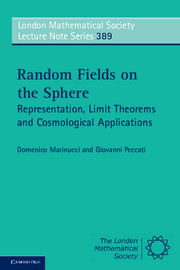Book contents
- Frontmatter
- Contents
- Preface
- 1 Introduction
- 2 Background Results in Representation Theory
- 3 Representations of SO(3) and Harmonic Analysis on S2
- 4 Background Results in Probability and Graphical Methods
- 5 Spectral Representations
- 6 Characterizations of Isotropy
- 7 Limit Theorems for Gaussian Subordinated Random Fields
- 8 Asymptotics for the Sample Power Spectrum
- 9 Asymptotics for Sample Bispectra
- 10 Spherical Needlets and their Asymptotic Properties
- 11 Needlets Estimation of Power Spectrum and Bispectrum
- 12 Spin Random Fields
- 13 Appendix
- References
- Index
5 - Spectral Representations
Published online by Cambridge University Press: 07 October 2011
- Frontmatter
- Contents
- Preface
- 1 Introduction
- 2 Background Results in Representation Theory
- 3 Representations of SO(3) and Harmonic Analysis on S2
- 4 Background Results in Probability and Graphical Methods
- 5 Spectral Representations
- 6 Characterizations of Isotropy
- 7 Limit Theorems for Gaussian Subordinated Random Fields
- 8 Asymptotics for the Sample Power Spectrum
- 9 Asymptotics for Sample Bispectra
- 10 Spherical Needlets and their Asymptotic Properties
- 11 Needlets Estimation of Power Spectrum and Bispectrum
- 12 Spin Random Fields
- 13 Appendix
- References
- Index
Summary
Introduction
In this chapter, we present a number of representation results for random fields defined on ℝ3, or on the sphere S2. We shall focus on random fields whose law verifies some invariance properties, namely isotropy (i.e., invariance with respect to rotations) and/or stationarity (i.e., invariance with respect to translations).
Section 5.2 contains facts that are implicitly used throughout the rest of this book, connecting strong isotropy to group representations and the Peter-Weyl Theorem – with special emphasis on spherical random fields, that is, random fields indexed by the unit sphere. In Sections 5.3 and 5.4 we focus on weak versions of stationarity and isotropy and the associated spectral representations. In particular, the content of Section 5.4 provides alternate proofs (with no group theory involved) of some of the main findings of Section 5.2. Note that Section 5.3 and Section 5.4 are not used in the rest of the book, so that some technical details have been skipped in order to keep the presentation as concise and to the point as possible. Adequate references are given below: in general, for a textbook treatment of stationary and isotropic fields on ℝm, one can consult Yadrenko [201], Adler [2], Ivanov and Leonenko [104], Leonenko [125], Adler and Taylor [3] and the references therein.
The Stochastic Peter-Weyl Theorem
General statements
We will now use notions and definitions that have been introduced in Chapter 2. Let G be a topological compact group, and let dg be the associated Haar measure with unit mass.
- Type
- Chapter
- Information
- Random Fields on the SphereRepresentation, Limit Theorems and Cosmological Applications, pp. 114 - 133Publisher: Cambridge University PressPrint publication year: 2011

